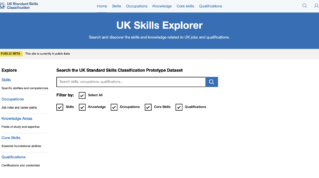Employers who recruit skilled workers from abroad will be asked to prove their sector invests enough in training for domestic workers, it has emerged.
Last week, the Migration Advisory Committee (MAC), an arm’s-length public body, published a draft “temporary shortage list” of mid-skilled level 3 to 5 jobs that are likely to be eligible for overseas recruitment from July next year.
And it revealed the government will call on employers to prove they will invest in training workers in the UK if they want to continue recruiting workers through the skilled worker visa route after that date.
The temporary shortage list is part of the government’s move to cut net migration by slashing the number of jobs that can be offered to people via the skilled worker visa route.
Under plans set out in the “restoring control over the immigration system” white paper, published in June, “expert” civil servants will be asked to produce “jobs plans” for every sector affected by the draft temporary shortage list.
Jobs on the list include roles in manufacturing, construction and creative industries, which are viewed as “potentially crucial” to the government’s industrial strategy and critical infrastructure plans.
It comes as the government takes an increasingly tough stance on immigration, including by removing skilled worker visa eligibility for around 180 occupations and axing the social care worker visa route in July this year.
Former home secretary Yvette Cooper said at the time: “As part of the plan for change, we can build an immigration system that serves the needs of the British economy and people – one that values skills, tackles exploitation, and ensures those who come to the UK make a genuine contribution.”
‘Make your plans ambitious’
Ahead of publication of a final temporary shortage list in July next year, various government-sponsored bodies including MAC, the Labour Market Evidence Group and “skills bodies” will assess how well jobs plans are “underpinned by a skills strategy”, show commitment to working with the Department for Work and Pensions on a “domestic labour strategy” and whether they are “sufficiently ambitious”.
The government is yet to confirm what evidence it will seek or what skills and training investment it expects employers to fund.
The MAC temporary shortage list report said: “Sector experts in government, in collaboration with industry, will lead the development of these documents, henceforth referred to as jobs plans, that outline plans for maximising the use of the domestic workforce and investment in training and skills.
“Occupations that proceed to stage two will need to be included in jobs plans if they wish to be considered for the [temporary shortage list], with the plans demonstrating the action that is being taken to support that occupation and reduce the need for migrant labour.”
The Labour government’s strategy of “linking immigration with skills” was first promised in its 2024 election manifesto.
Since then, political pressure to reduce net migration has increased.
But rollout of the policy appears to have been complicated by what MAC calls “competing policy priorities” in government between reducing migration and bolstering the country’s “economic security and resilience”.
Experts from the construction industry approve of the government’s “gradual” pace, arguing that while long-term plans to develop more home-grown talent are welcome, the sector needs the short-term “flexibility” of overseas recruitment to avoid missing the government’s manifesto pledge to build 1.5 million new homes in England by 2029.
Eddie Tuttle, director of policy, public affairs and research at the Chartered Institute of Building, criticised the “overly complex” apprenticeship system and called recent government construction skills initiatives, such as skills bootcamps and technical excellence colleges, “piecemeal and short-term”.
He added that only 7 per cent of construction employers have signed up as skilled worker visa sponsors as many view the administrative burden and cost as “prohibitive”, which is contributing to the continued shortfall in critical trades such as bricklaying and plastering.
Are the plans really needed?
Skilled worker visas were introduced in 2021 and, in the year to September, about 93,000 of the visas were issued to employees and their dependents who had been sponsored by an approved UK employer.
Sectors with the highest levels of recruitment via skilled worker visas in the year to April 2024 included accommodation and food service activities, motor vehicle retail and repair, professional, scientific activities, construction and manufacturing.
The government believes industries with high levels of overseas recruitment have failed to address the “underlying drivers of shortages” due to a “lack of comprehensive workforce plan”.
But Stephen Evans, chief executive of the Learning and Work Institute, warned the government already had “lots of plans”, including sector-focused plans accompanying the industrial strategy, local growth plans, local Get Britain Working plans, and local skills improvement plans.
He said: “Lasting change is best delivered by asking employers to lead on how their sectors will invest more in training, reversing the 36 per cent decline since 2005, and how they will work with public services on joined-up recruitment and training approaches.
So I hope that’s the approach the government takes.”














Is there such thing as an ‘expert’ civil servant ?
Good luck with that – another paper chase leading to nowhere.